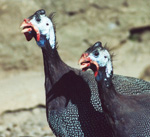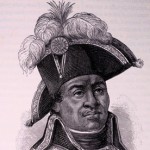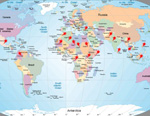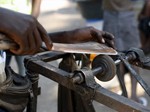Guinea Fowl or Pintade: a Photo Essay
By Dady Chery
Haiti Chery
Guinea Fowl (Pintade, or Numida ptilorhyncha) are variously described in a book by Jean-Marie Lamblard as:
“Birds of the mind who embody aspirations to ascend to the stars…. Ones who witnessed the birth of mankind and were partners to the first men on earth…. Ones who have never accepted domestication and look exactly as their ancestors did many thousands of years ago.”
The book guides the reader from Pharaonic Egypt to Alexandria, Greece, Abyssinia, Venice, Africa, and America in reverse order. The story includes the role of “oiseaux negres” in Haitian Vodou, where these birds are a symbol of the runaway slave because they reclaimed their freedom immediately after being introduced to the island in the early 16th century.

This guinea fowl, probably from Abyssinia, represents the bird of paradise, showing the promise of resurrection.

According to legend, amber originated from the tears of Meleager’s inconsolable sisters who, upon his death, turned into guinea fowl. Detail of a Roman sarcophagus.

To the ancient Greeks, the guinea fowl resulted from the metamorphosis of Meleager’s sisters into birds from their grief. In Greek, “guinea” meant meleagridis.

The people of the Nubians, the “Nehesiou”, whose name is written with the image of the bird of Nubia. Base of statue of Darius1st found at Susa. 5th century. Museum in Tehran.

Large group of guinea fowl, in east Africa. The text of a “Journey to Ouaday” by Sheikh Mohammed Ibn Omar El-Tounsy, translated into French in 1851, refers to an embassy gifts of guinea fowl eggs collected by thousands by east-African farmers.
- .
In memory of those lost today.
Sources: Haiti Chery | Based on the book: L’Oiseau Nègre: L’Aventure des Pintades Dionysiaques, by Jean-Marie-Lamblard, with a foreword by Ernest Pignon-Ernest. Publisher: Imago (2003) | Pintade, Oiseau Africain, Pintade et Mythologie











Comments
Guinea Fowl or Pintade: a Photo Essay — No Comments